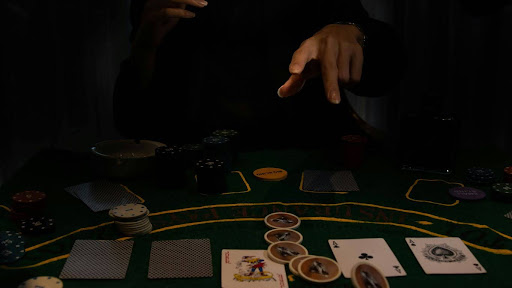Mississippi Stud is a casino table game that feels a lot like poker, but it’s played against a paytable, not the dealer or other players. The main idea is to make the best five-card hand you can using your two private cards, called hole cards, and three community cards that come out in stages. It’s a game that’s been around since the early 2000s, designed to be accessible to folks who might find traditional poker a bit much, but still offers enough strategy to keep experienced players interested. The core of playing Mississippi Stud well really comes down to knowing when to bet more and when to just walk away from the hand.
Introduction to Mississippi Stud Hole Card Strategy
When you first get your two hole cards, you have to make a decision: bet more or fold. This is where understanding your starting hand is key. Some hands are obviously strong, like a pair of Jacks or better, and these usually warrant a bigger bet. Others are weaker, maybe low, unconnected cards that don’t have much potential. You’ll also see hands that are somewhere in the middle – maybe a pair of sixes, or cards that could potentially form a straight or a flush. These require a bit more thought.
Here’s a general idea of how hands are often valued:
- 2-Point Cards: Jacks, Queens, Kings, and Aces. These are great because they pay 1:1 for a pair.
- 1-Point Cards: Sixes, Sevens, Eights, Nines, and Tens. A pair here usually just ties your bet.
- 0-Point Cards: Twos, Threes, Fours, and Fives. These don’t offer much profit when paired.
As the game goes on and more community cards are revealed, you get more information. This means you can adjust your strategy. A hand that looked okay at first might turn into something strong, or it might fizzle out. The trick is to keep evaluating your chances and make smart decisions at each step. It’s all about balancing risk and reward to make the best possible five-card hand.
The house edge in Mississippi Stud can vary quite a bit depending on how you play. Making good decisions, especially with your initial bets and subsequent raises, can significantly lower that edge, making the game more favorable for you over time. Conversely, poor choices can increase the house’s advantage.
Learning to read your hole cards and how they might combine with what’s coming is the first step to mastering this game. It’s not just about luck; there’s a definite skill involved in knowing when to push your bets and when to cut your losses. This is what makes the Mississippi Stud game so engaging.
How Hole-Card Exposure Changes Standard Mississippi Stud Play
In standard Mississippi Stud, your two hole cards are hidden, meaning you’re playing blind until the first community card appears. This changes things quite a bit. When your hole cards are exposed, you get a significant advantage because you know exactly what you’re working with from the jump. This upfront information means you can make much more informed decisions right from the start, rather than guessing based on probabilities alone.
The core difference is moving from a game of calculated risk based on potential to a game of direct assessment of your current hand strength. You’re no longer just hoping your two cards are good enough; you know if they are. This allows for more aggressive betting with strong starting hands and a much quicker fold with weak ones, cutting down on unnecessary losses.
Here’s how the exposure impacts your betting strategy:
- Strong Pairs: If you’re dealt a pair of Jacks or better, you know you have a hand that pays out. You can confidently bet more, often 3x your ante, because the odds of it improving or standing on its own are good. This is a big shift from not knowing if that pair of Jacks is worth pushing.
- Marginal Hands: Hands like 6s through 10s, or high cards with a weak kicker, become easier to evaluate. You might still bet, but perhaps less aggressively than with premium pairs, depending on the specific cards and potential draws.
- Weak Hands: Low, unconnected, off-suit cards that would normally be a quick fold in the standard game are even more obvious. There’s no point in throwing good money after bad when you can see your hand is a long shot from the beginning.
This early knowledge means you can adjust your betting across all stages more effectively. Instead of relying on a general strategy chart for unknown hole cards, you’re tailoring your bets to your specific situation. It’s like having a cheat sheet for your own hand before the game even really gets going. This is a key aspect of Mississippi Stud strategy.
The ability to see your hole cards fundamentally alters the risk-reward calculation. You can be more decisive, leading to fewer wasted bets on hands with little to no potential.
Consider this simplified breakdown:
| Starting Hand | Standard Play Decision | Exposed Hole Card Decision | Notes |
| Pair of Aces | Raise 3x | Raise 3x | Always a strong starting point. |
| Pair of 6s | Raise 1x | Raise 1x (or 3x if confident) | Payouts vary, but it’s a playable hand. |
| King-7 offsuit | Fold | Fold | Low potential, even when seen. |
| Queen-Jack suited | Raise 1x | Raise 1x-3x | Potential for straights/flushes is clearer. |
Knowing your hole cards removes a layer of uncertainty. It allows for a more direct and often more profitable approach to the game, especially when you’re trying to build a winning strategy.
Flop-Hole Card Strategy: Adjusting After Seeing the Flop
Once the first three community cards, often called the flop, are dealt, your decision-making process in Mississippi Stud needs a significant adjustment. This is where the game really starts to take shape, and your hole cards, combined with these new community cards, give you a much clearer picture of your hand’s potential. The key here is to re-evaluate your hand’s strength and potential draws based on this new information.
Think of it like this: before the flop, you’re making educated guesses. After the flop, you have concrete data. You’re looking to see if you’ve made a strong hand, if you have a good draw to a strong hand, or if it’s time to cut your losses. For instance, if you had two suited cards and the flop brings two more of that suit, you’ve just significantly improved your chances of hitting a flush. Similarly, if you had connectors and the flop provides cards that complete a straight draw, that’s a big development.
Here’s a breakdown of how to approach your betting after the flop:
- Made Hands: If you’ve already hit a strong hand, like a pair of Jacks or better, or even trips, you’ll generally want to bet aggressively. This is your chance to build the pot when you have the advantage.
- Strong Draws: Hands that have the potential to become very strong, such as four-card straights or four-card flushes, warrant continued betting. The amount you bet might depend on the strength of the draw and the potential payoff. For example, a four-flush is often a strong candidate for a 3x bet.
- Marginal Improvement: If your hand has improved slightly but isn’t yet a powerhouse, you might opt for a smaller bet, like 1x. This keeps you in the game without overcommitting if your hand doesn’t develop further.
- No Improvement: If the flop did nothing for your initial hole cards and you don’t have a promising draw, folding becomes the most sensible option. Continuing to bet on a weak hand is a quick way to deplete your bankroll.
The goal after the flop is to make a calculated decision based on the combined information of your hole cards and the community cards. Avoid emotional betting; stick to the probabilities and the potential of your hand. If your hand has a clear path to a strong outcome, bet. If not, it’s usually best to fold.
Understanding the point system can also be helpful here. Cards are often categorized by their potential to form pairs. High cards (J, Q, K, A) are worth 2 points, middle cards (6, 7, 8, 9, 10) are worth 1 point, and low cards (2, 3, 4, 5) are worth 0 points. This system helps in evaluating the strength of your hand and its potential to improve, guiding your betting decisions on 3rd Street.
Consider this general guideline for betting after the flop:
| Situation | Recommended Bet | Notes |
| Pair of Jacks or better | 3x | You have a made hand. |
| Pair of 6s-10s | 1x | A decent hand, but be cautious. |
| Four to a flush or open-ended straight draw | 3x | Strong drawing potential. |
| One high card with draw potential | 1x | Keep it in for a chance to improve. |
| No realistic draw or weak hand | Fold | Don’t throw good money after bad. |
Turn-Hole Card Strategy: Decisions with More Information

By the time the turn card hits the felt, you’ve got a pretty good picture of where things stand. You’ve seen your hole cards, the flop, and now the turn. This is where things get interesting, especially if you’re playing with a hole-card strategy. You’re not just reacting to the board anymore; you’re factoring in what you know about your own hand and how it might play out.
Think about it: if you’ve got a strong starting hand, say a pair of Queens, and the flop brings two more Queens, you’re sitting pretty. Now, the turn card comes. Is it a blank that doesn’t help anyone? Or does it complete a potential straight or flush for someone else? Your decision to bet, raise, or fold needs to account for this new piece of information. The turn card is a critical juncture for re-evaluating your hand’s strength and potential.
Here’s a general idea of how you might adjust your betting on the turn, assuming you have some insight into your hole cards:
- Strong Made Hands: If you’ve got a monster hand (like three of a kind or better), you’re likely looking to bet aggressively. The goal is to build the pot and get value from players who might still be drawing or have weaker made hands.
- Drawing Hands: If you’re on a draw (like a flush or straight draw), the turn card’s impact is huge. Did it help you complete your drawing? If so, you might consider a bet or raise to protect your hand and get paid off. If it didn’t help, you need to decide if the odds are still good enough to continue.
- Weak Hands: For hands that are unlikely to improve significantly, the turn is often where you decide to cut your losses. Unless the turn card dramatically improves your hand or gives you a strong draw, folding is usually the smart play.
The key here is not to get fixated on what you wanted to hit. Instead, focus on what the cards actually are and what they mean for your hand’s current standing and future possibilities. This objective assessment is what separates a winning player from someone just hoping for the best.
Let’s look at a simplified scenario. Imagine you’re playing Mississippi Stud and you know your hole cards are a pair of 8s. The flop comes 8-K-3. You’ve got three of a kind. Now, the turn card is a 7. This card doesn’t change your hand, but it could potentially help someone else make a straight (if they have a 5-6 or 9-10). If the turn was a King, it would give someone else two pair, which is still weaker than your trips, but something to consider. Your betting strategy on the turn will depend on how much action you expect and how likely it is that your hand is still the best.
River-Hole Card Strategy: Final Bets with Full Context
By the time the river card is dealt, you’ve seen all five community cards and have a complete picture of your hand’s potential. This is the moment for your final bet, and it should be a calculated decision based on everything that’s happened so far. Your goal here is to maximize your winnings if you have a strong hand, or to cut your losses if your hand hasn’t materialized.
Think about what you’ve got. Do you have a made hand, like a pair of Jacks or better, a straight, or a flush? Or are you still working with a draw that might or might not pay off? The strength of your hand relative to what’s on the board is key. If you’ve got a monster hand, you’ll want to bet aggressively. If your hand is just okay, or if it’s a weak draw, you might consider a smaller bet or even a fold, depending on the payout structure and your risk tolerance.
Here’s a general breakdown of how to approach your final bet:
- Strong Made Hands: If you have a pair of Jacks or better, a straight, a flush, or a full house, this is where you bet big. You’ve likely got the best hand, so push your advantage. A 3x bet is often appropriate here.
- Marginal Made Hands or Strong Draws: If you have a pair of 6s through 10s, or a very strong draw (like four cards to a straight flush), you have a decision to make. A 1x bet might be suitable, especially if you think you can still improve or if the payout for your current hand is decent. Consider the odds of completing your draw versus the potential payout.
- Weak Hands or Unlikely Draws: If your hand hasn’t improved significantly and you don’t have a realistic chance of making a strong hand, folding is usually the best course of action. Continuing to bet on a weak hand is a quick way to lose money. You might have seen some interesting hands during play, but the river is the final call.
Remember, Mississippi Stud is a game of calculated risks. The final bet is your last chance to capitalize on your hand’s strength. Don’t let emotion dictate your play; stick to the strategy that has brought you this far.
It’s also worth noting that some players might adjust their final bet based on the dealer’s actions or perceived patterns, though this is less common in Mississippi Stud than in other games. The core strategy remains focused on the strength of your own hand. For those looking to refine their approach to various poker games, understanding the optimal strategy for Three Card Poker can offer additional insights into disciplined betting.This game also rewards careful decision-making.
General Rules & Guidelines for Mississippi Stud Hole Card Strategy
When playing Mississippi Stud, especially when you’re thinking about your hole cards, it’s good to have some basic rules to follow. These aren’t set in stone for every single hand, but they give you a solid starting point. Think of them as your go-to advice when you’re not sure what to do.
- Always consider the point value of your hole cards. Cards like Jacks, Queens, Kings, and Aces are worth 2 points. Sixes through Tens are worth 1 point, and anything lower than a six is worth 0 points. This helps you quickly assess your starting hand’s potential.
- Don’t be afraid to fold weak hands early. If your two hole cards are low, off-suit, and don’t connect in any way, it’s usually best to just fold. Saving your money on these hands is a big part of the strategy.
- Be aggressive with strong starting hands. If you get a pair of sixes or better, or two high cards (like a King and a Queen), you generally want to bet more.
- Pay attention to how your hand develops. As the community cards come out, see if your hand is improving. A hand that looked okay might become a strong contender with the right draw.
Here’s a quick look at betting actions based on your initial hole cards:
| Hand Strength | Action |
| Pair of Jacks or higher | Bet 3x Ante |
| Pair of 6s-10s | Bet 1x Ante |
| Two high cards (J+) | Bet 1x Ante |
| Suited connectors (6-10+) | Bet 1x Ante |
| Anything else | Fold |
The goal is to make smart decisions based on the information you have. Don’t get too attached to a hand if it’s not improving. Discipline is key to long-term success in this game.
Common Mistakes Players Make in Hole-Card Strategy

When playing Mississippi Stud, especially when hole cards are exposed, players often fall into a few common traps. One big one is getting too attached to a hand that looks promising early on but has little chance of developing. Players frequently overbet or continue betting on hands that have very little potential to improve into a winning hand by the river. This often happens when a player sees a pair or a potential draw on the flop and gets excited, forgetting to assess the odds of actually completing that draw. It’s easy to get caught up in the possibilities, but a disciplined approach is key.
Another mistake is not adjusting the betting strategy based on the revealed hole cards. The standard strategy for Mississippi Stud is built on probabilities without hole-card information. When you know what some of your cards are, those probabilities change. Forgetting to factor this in can lead to costly errors. For instance, if your hole cards are low and unsuited, and the community cards are also low and unsuited, continuing to bet aggressively might be a losing proposition, even if you have a small pair.
Here are some common pitfalls to watch out for:
- Ignoring the impact of hole cards on odds: Players might stick to a standard betting chart without considering how their specific hole cards alter the likelihood of making a strong hand. This is especially true for draws; knowing you have two specific cards can significantly change the number of outs you actually have.
- Overvaluing marginal hands: Hands that look okay on the flop, like a weak pair or a gutshot straight draw, can be tempting to play. However, without strong hole cards or good community cards, these hands often lead to losses.
Practice Tips & Tools to Master Mississippi Stud Hole Card Strategy
Getting good at Mississippi Stud hole card strategy takes more than just reading about it. You’ve got to put in some time. One of the best ways to start is by using a strategy chart. These charts lay out the best move – raise or fold – for almost any situation you’ll face. Sticking to a chart, especially when you’re starting, can really help you avoid costly mistakes. It’s like having a cheat sheet that tells you what to do, so you don’t have to guess.
To really get a feel for it, try playing online. Many sites offer free play modes where you can practice without risking any real money. This is a great way to test out different plays and see how they work out over many hands. You can also find simulators that let you play out thousands of hands quickly, giving you a lot of experience in a short amount of time. This helps you see patterns and understand the long-term results of certain decisions.
Here are a few things to focus on during practice:
- Card Point Values: Get comfortable with the 2-1-0 point system. Knowing if your hole cards are high-value (2 points), medium-value (1 point), or low-value (0 points) is key to making good decisions.
- Draw Potential: Pay attention to how your hand can improve with the community cards. Are you close to a straight or a flush? This can change a weak hand into a strong contender.
- Bet Sizing: Practice adjusting your bet sizes. A 3x raise with a strong hand is different from a 1x raise with a marginal one. Learn when to push more chips in and when to hold back.
Don’t get discouraged if you make mistakes. Everyone does, especially when they’re learning. The important thing is to learn from those mistakes and keep practicing. Think of each hand as a lesson, and you’ll get better over time.
For those who want to go deeper, some advanced players even use software that analyzes hand histories. While this might be overkill for most, it shows the dedication some put into perfecting their game. For most players, though, consistent practice with a good strategy chart and free play modes is the way to go. You might also want to check out resources on other casino games, like Blackjack odds, to get a broader sense of casino strategy.
Want to get better at Mississippi Stud and learn about hole card strategy? We’ve got some great tips and tools to help you out. These simple tricks can really boost your game. Ready to improve your play? Visit our website today for all the details on mastering Mississippi Stud!
Frequently Asked Questions
What exactly is Mississippi Stud?
Mississippi Stud is a casino card game that’s like poker, but you play against a payout chart, not the dealer or other players. The main idea is to make the best five-card poker hand you can using your two private cards and three shared cards. It’s designed to be fun for both new and experienced players.
How do I know when to bet more money or give up?
Figuring out when to raise your bet or fold your hand is the most important part. You should bet more if you have a good starting hand, like a pair of sixes or higher, or if the shared cards help you build a strong hand. If your hand looks weak and isn’t improving, it’s usually best to fold to save your money.
What are the best hands to play in Mississippi Stud?
You’ll want to bet more on hands that already have good value, such as pairs of sixes or better. Also, keep an eye on hands with high cards or ones that have the potential to become straights or flushes. If your hand doesn’t have much promise, folding early is a smart move.
Does Mississippi Stud have good odds for players?
When played with the best strategy, Mississippi Stud can offer fair odds. The house edge is lower when you make smart decisions. While it’s not a game where you can easily count cards like in blackjack, using a good strategy helps you get the most out of your play.
What are some common mistakes players make?
A big mistake is playing weak hands for too long, hoping they’ll get better. Another common error is betting too much on small pairs that usually just push (tie). Players also sometimes forget to consider the potential for their hand to improve with the next cards, or they get upset after losing and make bad bets.
How can I get better at the Mississippi Stud strategy?
To improve, practice is key! You can use strategy charts that tell you the best move for every situation. Try playing online or with friends to get a feel for the game. Remembering to stay calm, manage your money wisely, and stick to your strategy will help you play better.
Daniel Chase is a seasoned casino analyst and iGaming writer with over 10 years of experience in the online gambling industry. He specializes in game strategy, casino odds, and player-focused reviews. Daniel is passionate about helping players make smarter decisions through transparency, real data, and honest insight.











